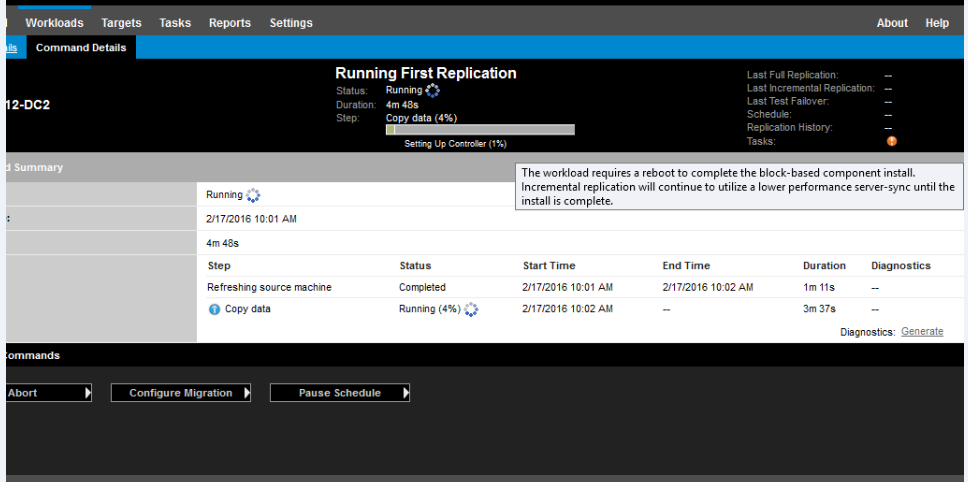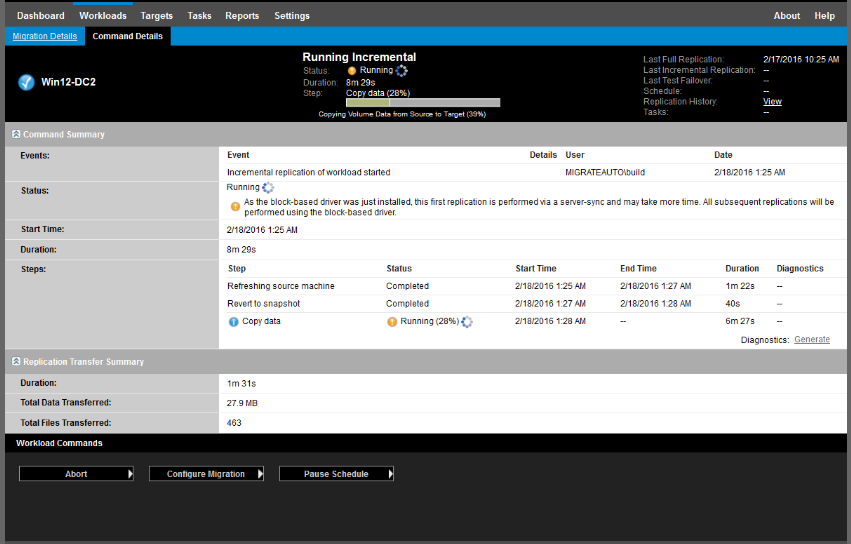8.0 MigrateAgent Utility
The MigrateAgent (MigrateAgent.cli.exe) is a command line utility that you can use to install, upgrade, query, or uninstall the block-based transfer drivers. Although a reboot is always required when you install, uninstall, or upgrade drivers, the MigrateAgent utility allows you to better control when the action occurs and therefore, when the server reboots. For example, you can use the MigrateAgent utility to install the drivers during scheduled down time, instead of during the first replication.
The syntax of the MigrateAgentutility is:
MigrateAgent.cli.exe [Option] [/psserver=%IP%]
Table 8-1 describes the options and switch available for the MigrateAgent.cli.exe command.
Table 8-1 MigrateAgentCommand Options and Switch
|
Usage |
Description |
|---|---|
|
Options |
|
|
h |? | help |
Displays usage and options for the command. |
|
logs | view-logs |
Opens the application log directory. |
|
status |
Shows installation status for the PlateSpin controller and drivers. |
|
din | driver-install |
Installs the PlateSpin drivers. |
|
dup | driver-upgrade |
Upgrades the PlateSpin drivers. |
|
dun | driver-uninstall |
Uninstalls the PlateSpin drivers. |
|
Switch |
|
|
/psserver=%IP% |
Downloads the block-based transfer drivers from the specified server when you invoke the status, driver-install, or driver-upgrade options. |
A copy of the block-based transfer drivers is bundled with the MigrateAgent utility. You can alternatively specify the /psserver= command line switch in order to download the drivers from the PlateSpin Server when you invoke the status, driver-install, or driver-upgrade options. This is useful when the server is patched with a new driver package, but the MigrateAgent command line utility is not patched.
NOTE:To avoid confusion, the recommended method of using the MigrateAgent is to install, uninstall, or upgrade the drivers and then reboot prior to doing a replication.
You should reboot the system each time you install, upgrade, or uninstall the drivers. The reboot forces the running driver to stop and the new driver to be applied on system restart. If you do not reboot the system prior to replication, the source continues to act as if the operation has not been completed. For example, if you install drivers without rebooting the system, the source acts as if no driver is installed during replication. Similarly, if you upgrade the drivers without rebooting, the source continues to use the already running driver during replication until you reboot the system.
If the version of the installed driver is different than the version of the running driver, the status option will remind the user to reboot. For example:
C:\MigrateAgent\MigrateAgent.cli.exe status
Step 1 of 2: Querying the PlateSpin controller service
Done
Step 2 of 2: Querying the installed PlateSpin driver version
Done
The task completed successfully
PlateSpin Controller Service Status
The PlateSpin Controller service is not installed
PlateSpin Driver Status
Installed Driver Version: 8.0.0.11
Running Driver Version: Not running. Reboot to load the driver.
Upgrade Available: No
PlateSpin creates a task to warn the user that a reboot is necessary in order to complete the driver installation or upgrade. The notification appears in the Tasks list (Figure 8-1). During replication, the notification appears on the Command Details page (Figure 8-2).
Figure 8-1 Reboot Notification Task

Figure 8-2 Reboot Notification During Replication

Rebooting the source machine applies and starts the installed or upgraded drivers. If the driver was recently installed, after the reboot, one full replication or a server-sync replication is required in order to ensure that all of a source’s changes are captured. This server-sync replication will be represented to the user in the Status field as a warning (Figure 8-3). Subsequent incremental replications will complete without warning.
Figure 8-3 Server-Sync Required Notification
